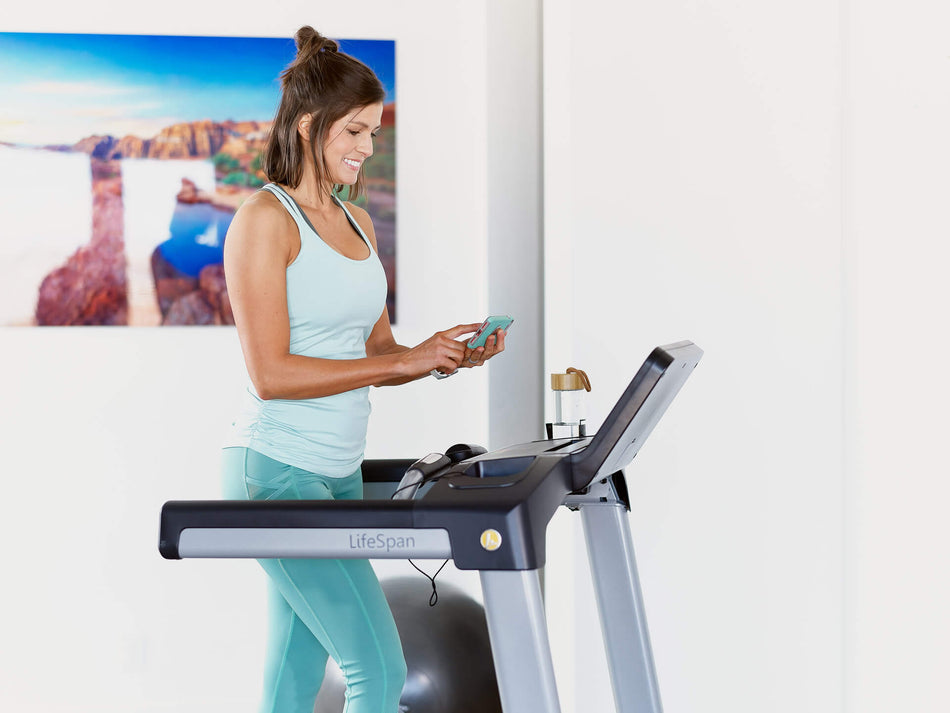It’s the question on most people’s minds: how many calories do I need to eat to lose weight? It’s not an easy question to answer and a range of factors can impact how people gain and lose weight.
In this article, we’re discussing what you need to pay attention to when using calories for healthy weight loss. It’s important to understand that healthy weight loss isn’t only about eating fewer calories than you burn throughout the day (yes, you will lose weight if you eat less than you intake). However, it’s also about what kind of calories you consume and maintaining a healthy overall lifestyle.
At LifeSpan, we believe you should have access to the fitness equipment and resources you need to maintain a healthy weight. That’s why we provide our customers with treadmill desks, under-desk bikes, and tools such as calorie counters. Fitness isn’t about how much you weigh. It’s about how healthy you feel. LifeSpan is here to ensure you feel healthy in every aspect of your life.
How Many Calories Should You Eat On Average?
The number of daily calories you need depends on a variety of factors, including your sex, age, height, weight, activity level, and metabolic health. Other factors, such as genetics, can influence your optimal caloric intake for weight loss. The bottom line is that if you’re trying to lose weight, a caloric deficit is critical.
But you don’t want to compromise your health by forcing a caloric deficit. You should ensure you’re eating enough calories to give your body the necessary nutrients, even if you’re trying to lose weight.
This brings up the idea of sustainable weight loss. Sustainable weight loss isn’t about how much you can lose in a month. It’s about keeping a healthy weight over time. That’s why many experts recommend small caloric reductions.
Fad diets might recommend restricting your calorie intake to 1,000-1,200 calories per day, which is hardly enough for most healthy adults. Furthermore, cutting your caloric intake too much can cause several adverse effects and even lead to nutritional deficiencies. This might result in metabolic changes that make long-term weight loss even more difficult.
U.S. Department of Agriculture 2020-2025 Dietary Guidelines for Americans
The following provides a closer look at how many calories you should eat based on the U.S. Department of Agriculture’s recommendations:
Women
- Age 19-30 - 2,000-2,400 calories per day.
- Age 31-59 - 1,800-2,200 calories per day.
- Age 60+ - 1,600-2,000 calories per day.
Calorie needs for women depend on their age, size, and activity level and the exact number they need might be higher or lower than the recommended numbers. These estimates also don’t apply to pregnant or breastfeeding women as they require more calories to sustain a healthy lifestyle.
Men
- Age 19-30 - 2,400 - 3,000 calories
- Age 31-59 - 2,200 - 3,000 calories
- Age 60+ - 2,000 - 2,600 calories
As with women, caloric needs for men vary based on several factors. Energy needs decrease as you get older as well. Very active men will need more calories.
Children
- Age 2-4 Male: 1,000 - 1,600 calories Female: 1,000 - 1,400 calories
- Age 5-8 Male: 1,200 - 2,000 calories Female: 1,200 - 1,800 calories
- Age 9-13 Male: 1,600 - 2,600 calroeis Female: 1,400 - 2,200 calories
- Age 14-18 Male: 2,000 - 3,000 calories Female: 1,400 - 2,200 calories
Children have a wide variation between their caloric intake recommendations based on their age, size, and activity levels. Something else to consider is that energy levels between children and teens vary greatly as well. For example, a three-year-old might only need 1,200 calories while a teenager might require nearly 3,000 calories.
What Are Calories?
A calorie is a unit of measurement for energy. Using calories is the easiest way to determine whether you’re eating too much or too little to lose weight. It’s important to keep in mind that while the weight loss principle for calories might seem simple, many factors contribute to weight loss. So while calories are a useful tool for weight loss, they aren’t the sole thing to take into consideration. Below, we detail some simple ways you can reduce your caloric intake.
Eat More Protein
Protein is an important component of curbing your appetite and helping you feel full. It might also help fight cravings. Protein-rich foods also sustain energy exceptionally well. They not only sustain energy, but they also help burn calories. A markedly higher DIT than fat and carbohydrates means protein conserves REE by preventing lean muscle mass loss.
Limit Sugary Drinks
This one might be more difficult for some than others, but limiting your sugar intake by eliminating sugary beverages, including sodas, fruit juices, chocolate milk, and other drinks can help. One of the reasons why limiting sugary drinks is so effective has to do with the lack of satiety they provide compared to food.
Liquid calories don’t affect your feelings of hunger as much as solid calories. Studies have also linked sugary beverages with an increased risk of obesity. Sugar also produces harmful effects that go beyond weight gain.
Drink More Water
One of the simplest ways to increase your chances of weight loss is to drink more water. Increased hydration improves brain health and weight management while reducing risks of kidney stones. Additionally, drinking water before meals can reduce your feelings of hunger and lead you to eat fewer calories.
Exercise
Calorie restriction can reduce your metabolic rate and increase your appetite. It might also lead to muscle loss and harm your overall health. Resistance training can limit muscle loss and minimize metabolic changes during long-term calorie restriction. If you can’t go to the gym, you should consider bodyweight exercises, such as push-ups, squats, and sit-ups at home.
Another easy way to burn more calories is using an at-home workout setup. With LifeSpan treadmill desks and under-desk bikes, you can even exercise while at work.
Reduce Refined Carbs
Refined carbs describe grains that no longer have bran or germ. These grains include white bread, pasta, crackers, and white rice. It can also include sugar and sweeteners. These types of grains lack fiber, which can support weight loss by decreasing your appetite. Eating fewer refined carbs can also promote weight loss by altering specific hormones that regulate appetite, such as peptide YY.
Low-carb, ketogenic diets won’t be for everyone, but replacing refined carbs with nutrient-dense, fiber-rich carbs, such as whole grains, root vegetables, nuts, seeds, and legumes can help accelerate sustainable weight loss.
Things to Avoid When Using Calories As A Weight Loss Goal
Counting calories might be an effective strategy to lose weight, but you should remember there are other factors to consider when you choose what and how to eat. Focus on having a balanced diet rich in nutritious, whole foods. Doing so ensures you get the necessary vitamins, minerals, and nutrients your body needs to support an overall healthy lifestyle.
One of the reasons a calorie counter can be so effective for weight loss is that it helps you avoid reducing your caloric intake by too much. Doing so can have several serious side effects, including increased hunger, dizziness, fatigue, headaches, and nausea. It can also slow your metabolism and make it more difficult to lose long-term weight.
Sustainable weight loss takes a significant amount of time and it’s wise to focus on gradual changes rather than momentous ones that result in rapid weight loss. That’s one of the reasons why investing in a treadmill desk or under-desk bike is so helpful- it keeps you focused on living an active lifestyle rather than radical shifts in your approach to fitness.
Key Takeaways- How Many Calories Should I Eat for Weight Loss?
Answering the question of how many calories you should eat for weight loss isn’t possible with a single answer. You need to consider various elements of your diet. However, many calorie counters online can give you a relatively accurate estimate of your caloric needs.
Deciding your optimal caloric intake for weight loss is only one component of a healthy lifestyle. You should also consider the quality of the calories you intake as well as maintain a healthy lifestyle through regular exercise.
At LifeSpan Fitness, we believe our customers deserve the opportunity to be healthy at work and at home. That’s why we provide you with state-of-the-art treadmill desks and under-desk bikes. Our treadmill desks feature whisper-quiet motors and ergonomic designs to create a productive, comfortable work environment. And each of our fitness products features durable construction and generous warranties.
Whether you’re looking for some guidance on how many calories you should intake to lose weight or you want to add a little more activity to your work environment, LifeSpan Fitness is here for you. Browse our selection today and visit our calorie counter page to start living the healthy lifestyle of your dreams.
FAQs
How Many Calories Should You Eat to Lose Weight?
The number of calories you need to eat to lose weight varies from person to person. To support sustainable weight loss, you should avoid processed foods such as ice cream, fast food, and high-calorie snack foods. You can also try to increase your physical activity. Lastly, dieticians can help determine a healthy caloric intake for you to aim to achieve weight loss.
How Many Calories Should You Eat to Gain Weight?
If you want to gain weight, you need to achieve a caloric surplus. This means you intake more calories than you burn. However, healthy weight gain operates much the same as healthy weight loss. You shouldn’t sacrifice the quality of the calories you intake to satisfy a caloric goal.
How Many Calories Should You Eat to Gain Muscle?
Gaining muscle will require a caloric surplus and you should develop a strategy to accomplish this sustainably.






